I sometimes see hawks buried so deeply in trees that I can’t help but wonder how they’re going to fly out without injury or at least feather damage. They occasionally appear to “think” about their escape route just before take-off, which implies “planning”. Some images I took yesterday brought the question to mind once again – are hawks capable of “planning”?
- Planning – the process of thinking about and organizing the activities required to achieve a desired goal. Planning involves the creation and maintenance of a plan and as such is a fundamental property of intelligence. (Wikipedia)
1/2000, f/5.6, ISO 800, 500 f/4
Yesterday morning I found this juvenile Red-tailed Hawk buried deeply enough in this tree (notice that there are branches in front of and behind the bird) that flying out presented an obvious problem. At first I thought the bird would turn around and take off away from me because there were fewer obstructing branches in that direction but this bird took off toward me, possibly because the wind (blowing pretty hard) was coming from behind me.
Here the hawk is hunkering down and appears to be thinking about its options for take-off direction and strategies for avoiding collisions between wings and branches.
1/1600, f/6.3, ISO 800, 500 f/4
An instant later it launched on what appeared to be a collision course with the branches only inches away but the combination of wings and wind gave it enough instant lift to rise almost straight up into the air…
1/1600, f/6.3, ISO 800, 500 f/4
before gaining forward momentum…
1/1600, f/6.3, ISO 800, 500 f/4
and clearing the foliage as it flew almost directly toward me.
Did this hawk actually plan its take-off strategy, having considered factors like wind speed and direction, potential wing obstacles, the direction of its destination and the possible threat posed by me and my big pickup so close to the bird ? I wish I knew…
1/1600, f/7.1, ISO 640, 500 f/4, 1.4 tc
When I first found this Red-tailed Hawk (sequence taken this past summer in Montana) it was buried about as deeply in the brush as you can get. When it was ready to take off it walked as far out as it could on the darker branch that is its perch (as it’s doing here). It then paused for some time as it seemed to consider its take-off strategy in such an obstructed setting.
1/2000, f/7.1, ISO 640, 500 f/4, 1.4 tc
When it launched it did so with wings extended unusually high – possibly in a deliberate effort to avoid hitting the nearby branches with its wings.
1/1600, f/7.1, ISO 640, 500 f/4, 1.4 tc
As you can see, the bird had lots of twigs and branches to avoid on its way out (its nictitating membrane is even partially closed to protect the eye).
1/1600, f/8, ISO 800, 500 f/4
This red-tail (another example from yesterday) was perched on branches with fewer obstructions but those that were there were larger, less flexible and less forgiving of mistakes than in my first example. When it takes off the bird not only has to avoid hitting the branches on the left with its right wing but there’s more obstructing branches in the right foreground that you mostly can’t see until the next image.
1/1600, f/6.3, ISO 640, 100-400 @ 400mm
When it launched the hawk pushed off forward (mostly with its left leg) into the wind, kept its right wing less extended to avoid the branches on the left and seemed to be watching its left wing to make sure it misses the branches in front of it.
I can’t help but wonder how much of all this may actually be planned and how much may be instinctive or reflexive. Other examples of possible raptor planning come to mind – things like cooperative hunting in Harris’s Hawks and complex prey ambush strategies in some of the falcons and buteos.
Perhaps some of my readers may have some insight into this, particularly those with extensive raptor experience like falconers and rehabbers.
Maybe I’m making a mountain out of a mole hill but this is something I’ve been curious about for some time now.
Ron


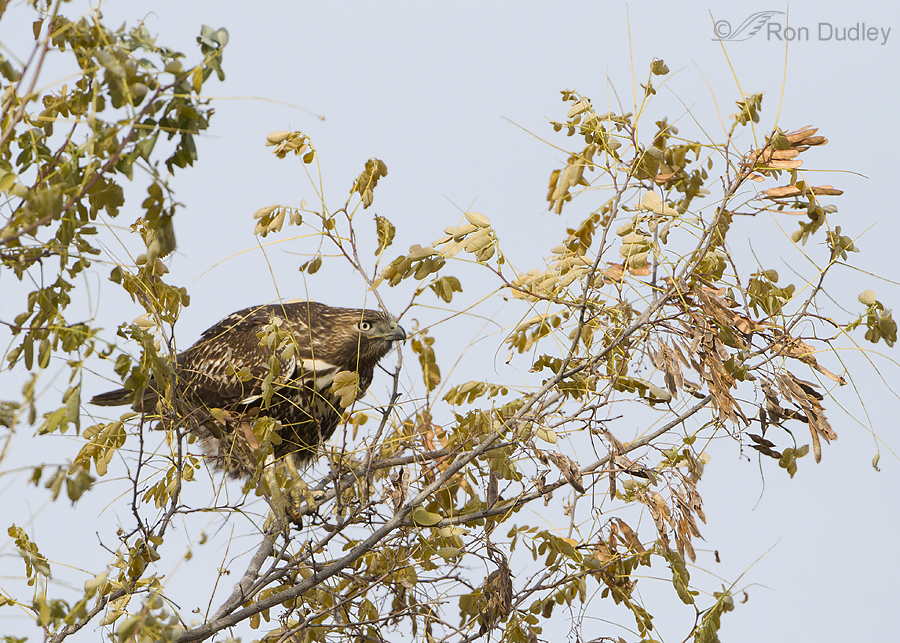
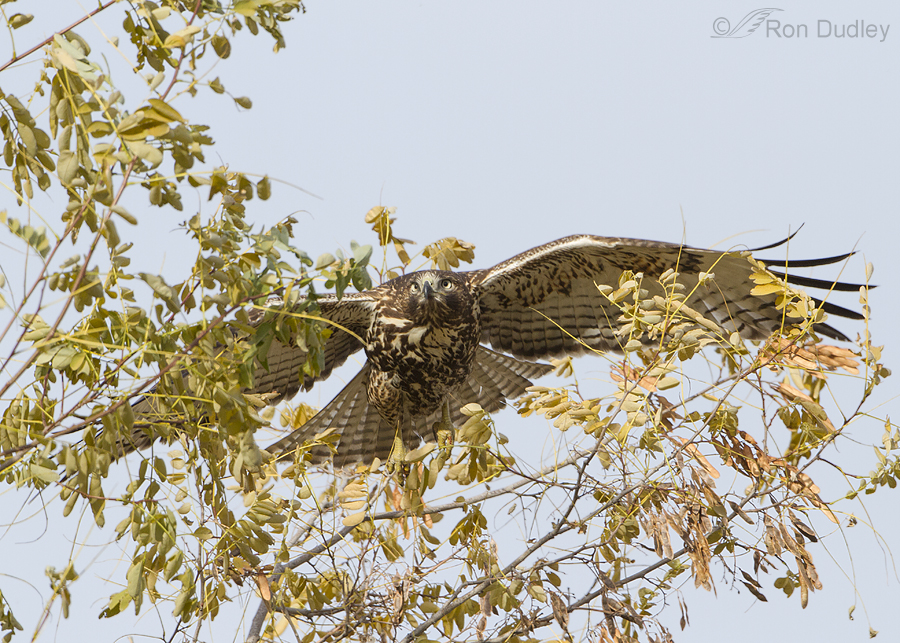
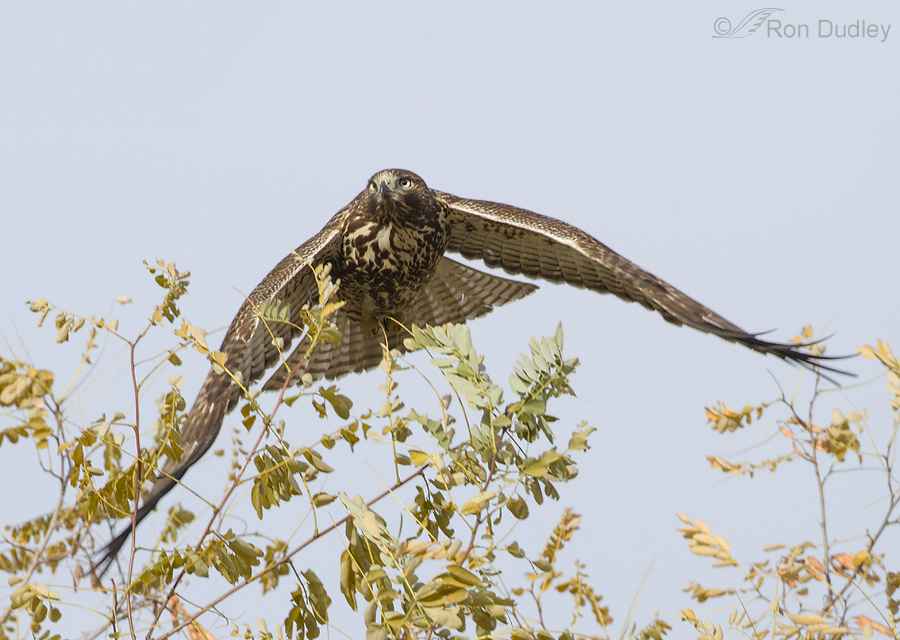
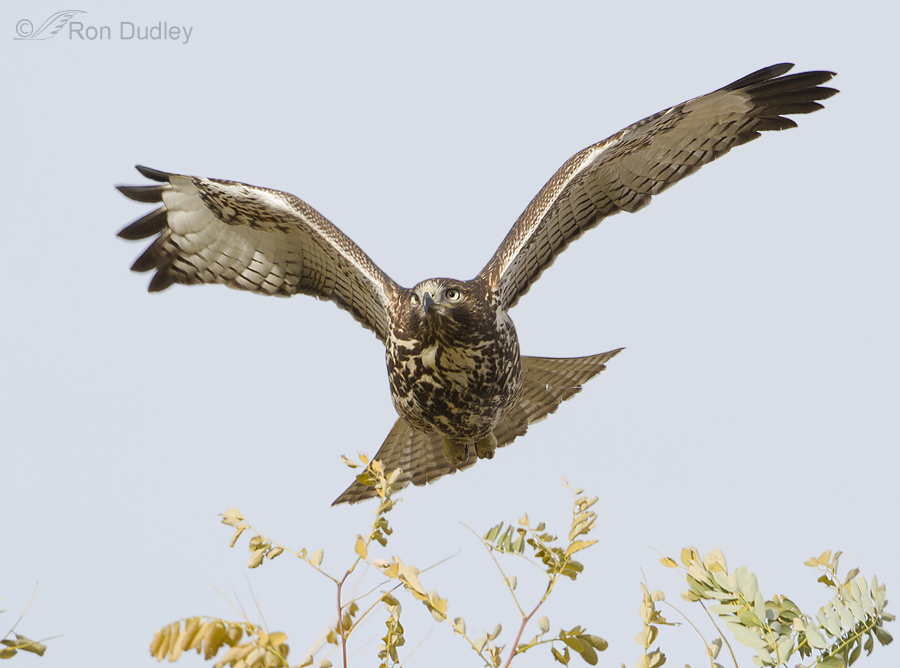
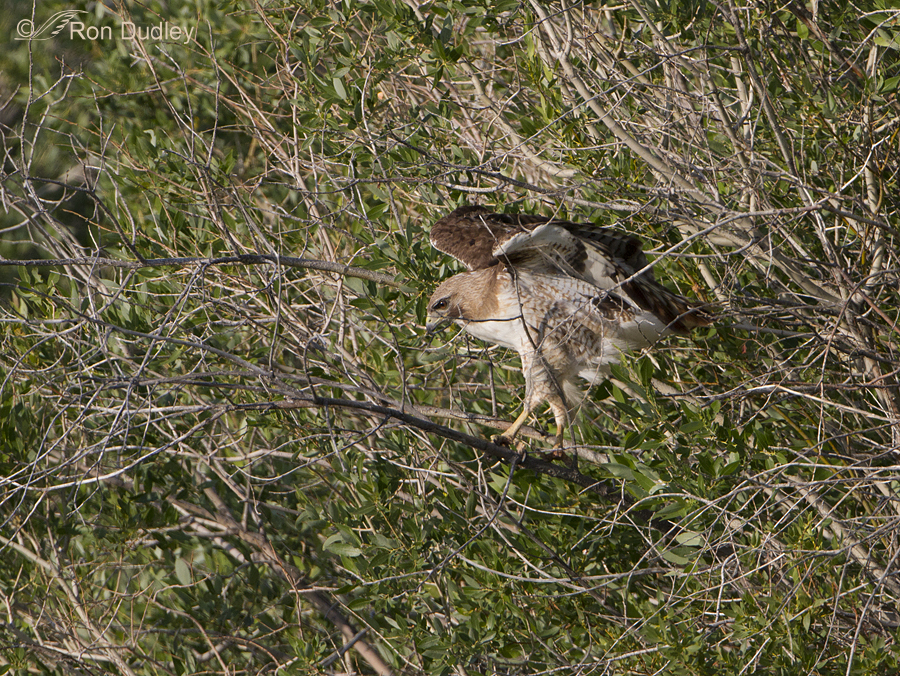
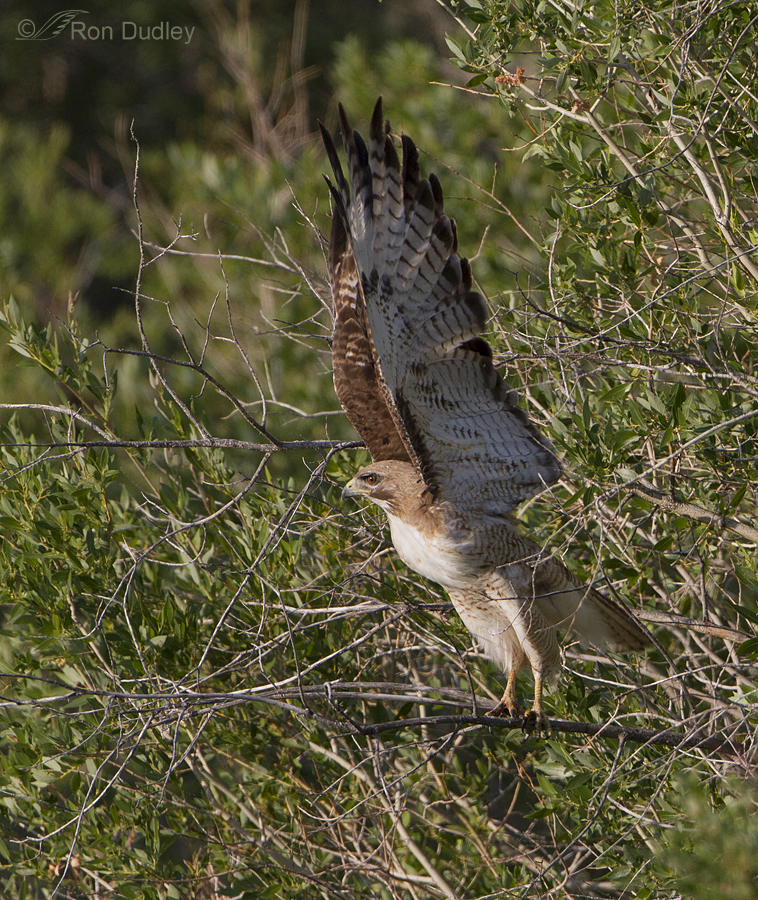
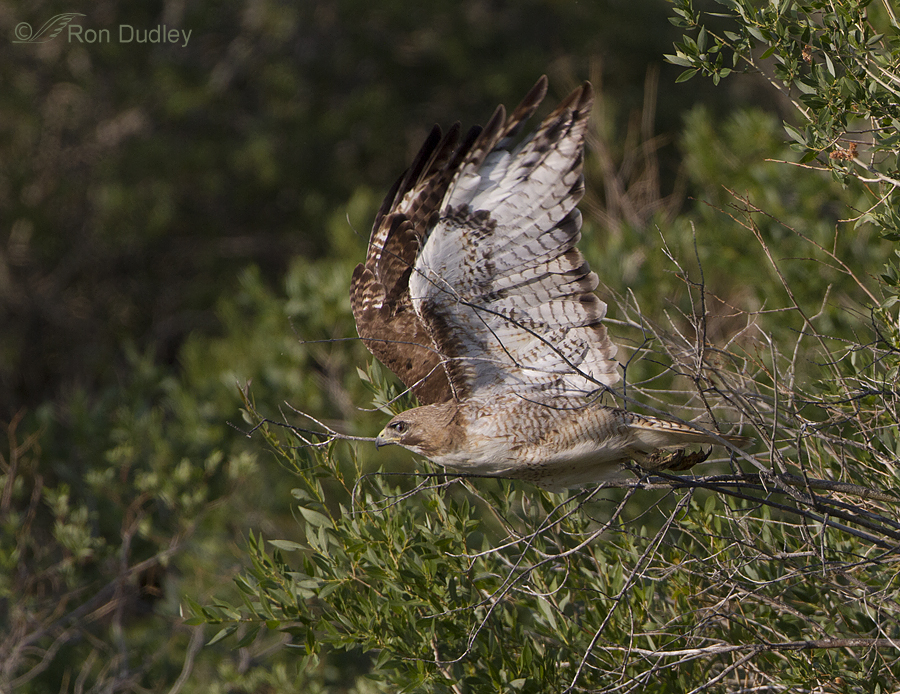
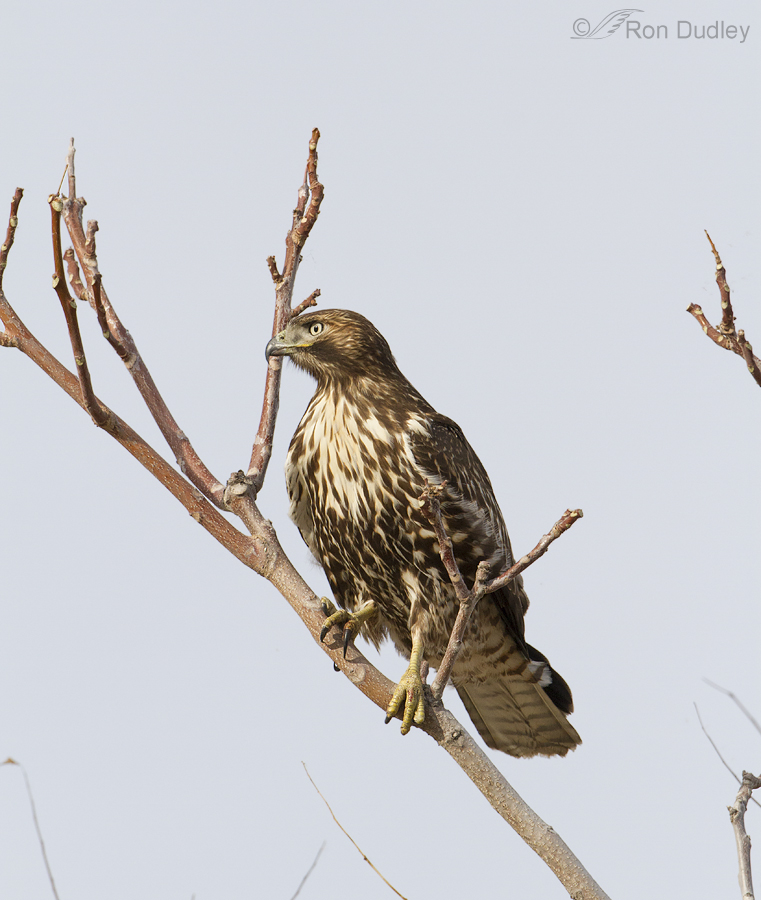
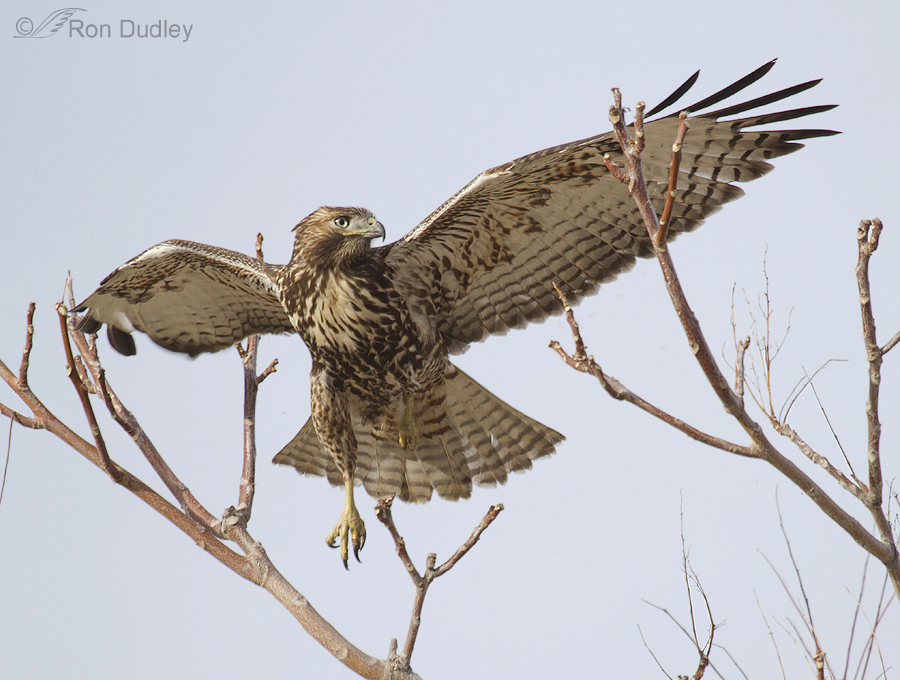
In our community (Tucson Arizona) there are a lot of Cooper’s Hawks as well as Redtails. I’ve watched Cooper’s Hawks take off from perches buried deep in vegetation or fly through densely leaved trees without mishap and it seems to me that they clearly aren’t blundering randomly forward. It would be impossible for them to navigate these obstacle-laden routes without a lot of planning.
I’ve been having problems with my computer so have missed your blog and comments…Have you seen ENT and are you OK?
I’ve emailed you with the details, Patty.
Wonderful shots as always Ron! I think hawks are fully capable of planning, although, like intelligence, it might be defined differently than the linear process we humans consider it to be.
I think you’re right, Mike. I always appreciate your input on things like this.
Seeings how the original question was about Redtail’s ability to plan I will attempt to avoid digressing to other forms of birds because it gets risky to generalize to such a large group. Here is some more fuel for the thought processes regarding Redtails:
http://raptorresource.blogspot.ca/2013/10/red-tailed-hawks-and-social-play.html
Bill
Interesting question. Or is it just an “inner compass.” or quick reflexes.I watched a TV show where they filmed a falcon flying through a hole in a net. It was going about 90km an hour and drew its wings in close to its body just as it went through the net. I think some planning has to be involved : knowing when to take off , aim for the target and hit the target.Planning AND practice.I just sat and watched birds coming to the feeders the other day, amazed at their dexterity. They almost always land on the side of the tree away from me or with the sun behind them,or in the midst of a lot of branches before going to the feeder.The way I see it, it is a smart protective strategy rather than a “coincidence.” M Firpi sounds like he has some knowledge on this, impressive. Love the poses in these photos – great light and detail.
Very entertaining! If you haven’t seen this you may enjoy it: A Goshawk flies through obstacles
http://www.youtube.com/embed/2CFckjfP-1E
Thanks, Tana. Anyone who hasn’t seen this clip, should…
There is tonnes of material on youtube involving raptors that is informative and educational.
Seeings how people have moved from Redtails thinking to corvids, etc. there are examples of various raptors using tools as a part of their strategies to survive.
Bill
Right on, Bill Dove!
Unbelievable shots and truly interesting material Ron!
Thank you, Charlotte.
What’s happening with your neck? Was it a blocked salivary gland? Was it swollen lymph nodes? Are you OK now? If they put you on antibiotics, ask if you should take something like Florastor also. Yes, I’m playing doctor…and yes, it could be worth checking out. I hope you feel better soon.
Patty, Tentative diagnosis is a blocked salivary gland. Symptoms are still present and painful. I’ve scheduled an appointment with an ENT specialist to follow up.
Good luck with the ENT visit…or as it would say on our medical group’s new receipts, “encounter” instead of visit.
I think one of my daughters had that..It was swollen, painful and she looked kind of like she had the mumps….they scheduled surgery for her, but day before surgery was scheduled, I asked the surgeon if he’d have it done on his own daughter, he said, “No”…so I told him to cancel. It eventually went away and she’s had no problems with it since. Your situation may be entirely different.
Fascinating input from all. Thank you everyone.
I’ll have to digest some of this information but doing so will have to wait. I spent almost the entire day in the emergency room with a painful and swollen upper neck (possible blocked salivary gland). Still not feeling too chipper so I may or may not get a blog post done for tomorrow.
I appreciate all your feedback on this post. A lot!
I am so sorry. Your health is MUCH more important than a blog post. Take care of yourself, and come back only when you are ready.
You do have interesting and thought provoking posts! We have a Common Blackbird (introduced species) pair with a nest in our courtyard at the moment, and my husband, who isn’t a birder, is fascinated with it. He’s noticed that when the female is on the nest, and the male has a food delivery to make, the male calls, and the females takes off. How do they call clearly with a mouth full of bugs, by the way?!
I don’t think it is just my admitted anthromorphism which makes me believe that yes, animals and birds DO plan. Very well. I saw a documentary about New Zealand’s kea which clearly shows their forward planning – and yes intelligence. Researchers set up a test which required two birds to co-operate so that ONE bird got a reward. Which they succeeded in doing very rapidly. And then they swapped roles so that both birds were rewarded.
My observations lead me to believe that the where-is-my-body-in-space skills develop as birds learn to fly, as they learn the physical capabilities of those wings. I get to see babies fly the first time. They get a focused look toward the next branch, and suddenly it all comes together and they have transported. I swear, they often look surprised. “Cool! How did I do that?” Then they practice. Sometimes they miss, or crash, or have to correct. Artistry, grace and speed takes lots of practice.
The African Gray parrot that lives with me was not allowed to fledge naturally, so he didn’t learn the skills as a chick. Now he’s learning to fly as a 4 year old. Unfortunately, you cannot learn to land until you learn to fly, so the poor guy is having a hard time learning landing. He’ll get airborne, then realize he has to “plan” his landing. He’ll circle the room frantically looking for a spot. At first he just splatted. Now he’s learning to pick a perch, slow down, extend the legs, adjust angles, until he can grab hold. But there is still lots of extra flapping and scrambling involved, finishing with a great sigh of relief to have touched down safely. I cheer for him.
I see hawks planning much more complicated tasks, as panicking Mourning Doves so they crash into windows. That takes knowledge of behavior and future consequences. And it works!
Ron: The title of your post captured my attention. After being an OTR for 10 years now, I immediately compared what you called “planning” with humans, where it’s called “motor planning”, and you test with sequencing motor acts. The clinical term for a lack of planning is called “Apraxia”, which according to Wiki: ” (from Greek praxis, an act, work, or deed[1]) is characterized by loss of the ability to execute or carry out learned purposeful movements,[2] despite having the desire and the physical ability to perform the movements. It is a disorder of motor planning, which may be acquired or developmental, but is not caused by incoordination, sensory loss, or failure to comprehend simple commands (which can be tested by asking the person to recognize the correct movement from a series). It is caused by damage to specific areas of the cerebrum”. If this hawk had brain damage it could not survive in the wild, obviously, but he could still have the desire to go after the prey; it just would not be able to motor “plan” the movements that are necessary. Children with developmental apraxia may not reach developmental milestones within expected time periods. But older adults and elderly also become “apraxic” due to old age and dementia; in which case it would be “acquired” apraxia, as with brain injury. Of course the hawks are able to plan, but it’s because their parietal lobes are intact and healthy. Now with animals I think it’s different. Animals are constantly “cued” by the environment. They’re “synchronised” with the environment in a way many of us still don’t understand; as opposed to humans; which must receive particular nurturing and stimuli at crucial young ages (to reach what they call the ‘developmental milestones’). With animals this process is more “seamless” (I guess it’s the word), more automatic, as opposed to that of humans which involves a whole set of biological aspects, but increase in complexity due to societal norms (e.g.:”how do I get food?” “I either get it from mom, or I have to learn how to cook”). You see, with humans, the planning becomes much more complex, relying much more on procedural memory, than animals have to ever deal with. This “synchronisation” with the environment is an advantage that animals will always have over us; we have so many codes of “learned” behaviours, which is what gets us in trouble. The problem with humans is precisely the fact they have not been able to adapt to environmental cues; therefore, they must re-invent tools constantly, to dominate it. Whichever these cues were, humans seem to have lost them. It is the story of human civilisation. The last image is gorgeous!
I also see now, that what you’re actually referring to here is what is known as “obstacle negotiation”, which also requires motor planning. Presumably, animals that are left in the wild with no human interference, also have a swifter and seamless transition to negotiate obstacles, as with the branches you so well portray here. Humans, on the other hand, are bound to stumble into hard objects more easily because, as mentioned above, we lack the environmental cues to negotiate these obstacles; therefore, I can trip over a small step I didn’t see walking, simply because it’s not in the environment in which I’ve learned. Animals don’t always have these problems because their environmental cues are attuned to nature; they know branches will bend and are flexible, and tree trunks are solid, so motor planning comes naturally for them. The problem comes with human interference. Birds are still not able to negotiate obstacles such as glass from windows built by humans. They cannot negotiate power line collisions. So their motor planning is actually delayed by human interference.
I love the photos. I’m wondering if for humans planning generally consists of plotting a sequence of tasks, rather than just one. Seems like the hawk clearly assesses… might that be the distinction?
Personally, I don’t believe it is a matter of if they think but more a matter of when vs instinct. In your examples the juvenile flying into “thick” cover can be the result of instinct to land somewhere but possibly a less than best choice. Redtails certainly need to learn where to land and how. Often new fledglings can be seen hanging from a branch. They even need to learn how to fly successfully. They have instincts to move their wings, feathers but must learn the effects of these actions and under varying conditions/forces. Now to fly out of the “thick” cover the bird will move to a clearer “launch pad” to leave that location (if one exists). We often anthropomorphize (and it’s done here allot) giving animals far greater credit than perhaps is warranted which often confuses the differences between instinct and thought.
Dodger: The RT may well be the most successful hawk in North America but is not considered the smartest. That perch is owned by the Harris.
Bill
lol…I knew I’d flush a Harris Hawk guy out with that comment!
Tim
I believe so. I’m reading a fascinating book right now called “Animal Wise: The Thoughts and Emotions of Our Fellow Creatures” by Virginia Morell. You might find it interesting. I love the hawks – especially the photo of the hawk with its wings raised so high.
I discovered that a large dragonfly could “think” about escaping, about bashing himself against glass or not…He chose NOT…and flew around checking things out, apparently weighing options…it appeared to be doing more “thinking” than many two-legged I see these days.
Human cognitive thinking is full of junk….like self doubt, self analysis, and “what will the neighbors think?” In that light, animals are better at planning then we are, because they are relying on memory and prediction. Animals don’t care what the neighbors think. Its a simple yes/no process…”do I remember this? “yes”… was it good? “yes” execute task. The level they do it at varies from species to species, but of course I’m condensing YEARS of studies into a quick post on one of my favorite blogs.
Tim
Oh…and thank you for using images of Red-Tailed Hawks to ask the question….lol. My unscientific research has determined that they are smartest raptors on the block.
Tim
Did he plan it? Why not? Don’t they plan when and where they’re going to nab something? I think you can safely bet your sweet bippy they do! My crow “planned” all kinds of stuff, so did my grackle, much of it “bad” for my husband, kids, me and the dogs…their planning and strategizing was obvious most of the time…allowing us to counter plan……. sometimes.